The ARM vs x86 Wars Have Begun: In-Depth Power Analysis of Atom, Krait & Cortex A15
by Anand Lal Shimpi on January 4, 2013 7:32 AM EST- Posted in
- Tablets
- Intel
- Samsung
- Arm
- Cortex A15
- Smartphones
- Mobile
- SoCs
SunSpider 0.9.1
The results get more interesting when we look at power consumption during active workloads. We'll start off with SunSpider, a mid-length JavaScript benchmark that we frequently use in our reviews:
At the platform level, Qualcomm's APQ8060 powered Dell XPS 10 falls in between Surface RT and Acer's W510. Active power looks very similar to the Intel powered W510, but performance is appreciably slower so total energy consumed is higher.
Looking at the CPU, the situation changes a bit. Intel's peak power consumption is similar to Tegra 3, while Krait manages to come in appreciably lower. I suspect that missing the L2 cache power island here is lowering Qualcomm's power consumption by 100 - 200mW but overall CPU-only power consumption would still be lower. Once again, at idle Krait seems to have a bit of an advantage as well.
The situation changes once we look at GPU power consumption, with Intel/Imagination having the clear advantage here.

Kraken
Mozilla's Kraken benchmark is a new addition to our js performance suite, and it's a beast. The test runs for much longer than SunSpider, but largely tells a similar story:
At the platform level, Acer's W510 has slightly higher peak power consumption compared to the Dell XPS 10 but it also completes the test quicker, giving it a better overall energy usage profile.
Looking at the CPU cores themselves, Qualcomm holds onto its lead here although once again, I suspect the margin of victory is exaggerated by the fact that we're not taking into account L2 power consumption for Qualcomm. Intel does deliver better performance, which allows the CPU to race to sleep quicker than on APQ8060A.
The comparison to Tegra 3 is not surprising, this is exactly what we've seen play out in our battery life tests as well.
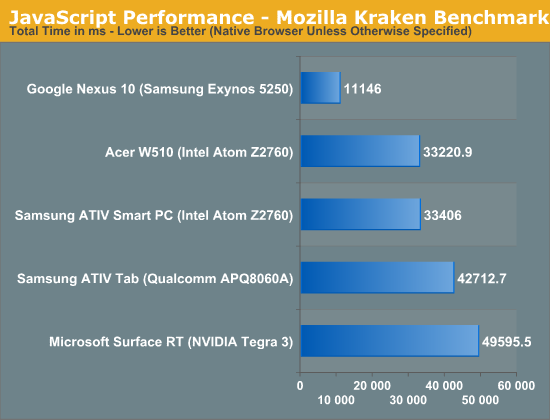
RIABench
RIABench's Focus Tests are on the other end of the spectrum, and take a matter of seconds to complete. What we get in turn is a more granular look at power consumption:
Here the W510 consumes more power at the platform level, but drops to a lower idle state than the XPS 10. Surface RT clearly uses more power than both.
Krait's CPU level (excluding L2 cache) power consumption is once again lower than Atom's, but Atom completes the task quicker. In this case total energy usage is still in Qualcomm's favor. The fact that there's a discrepancy between CPU specific power results and the total platform results are partly due to the missing L2 cache power consumption data from the CPU power chart for Qualcomm, and partly due to differences in the tablets themselves.
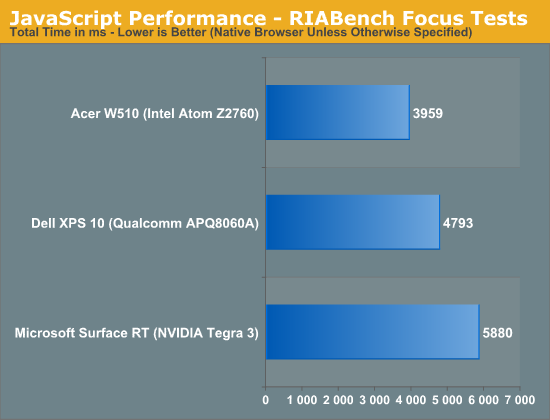


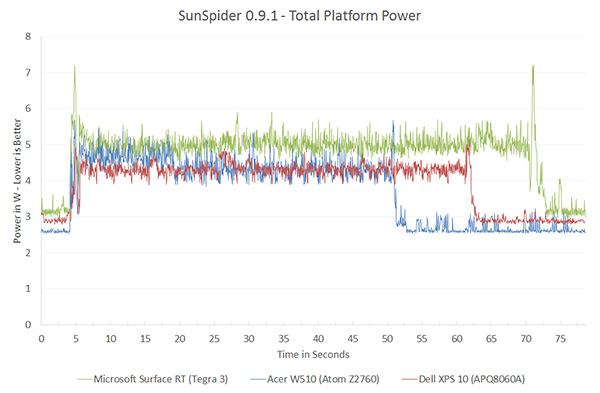


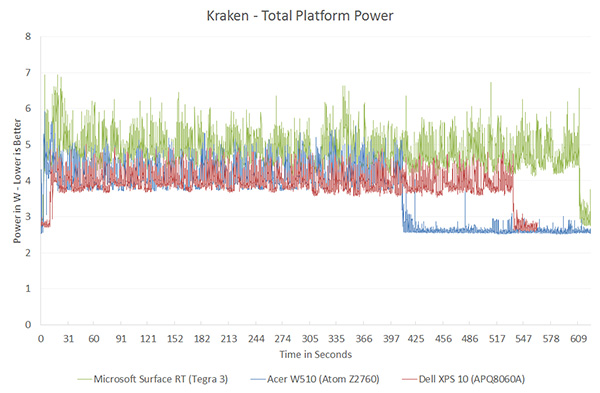
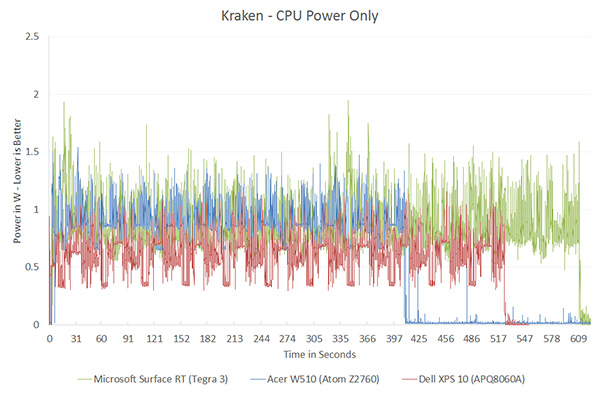
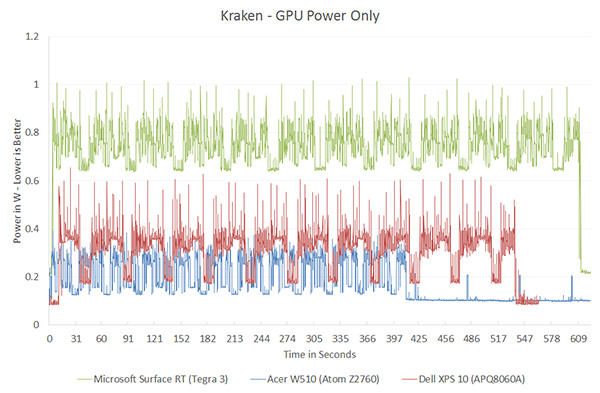
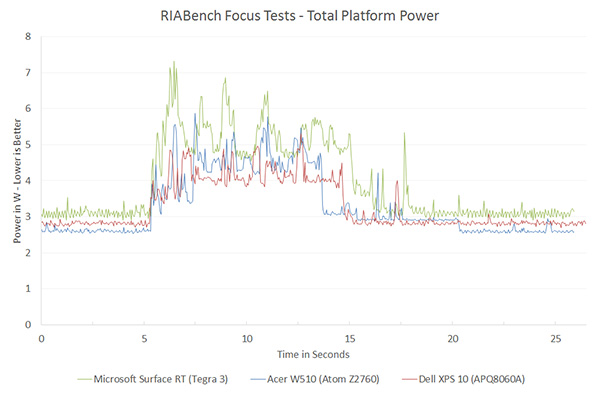
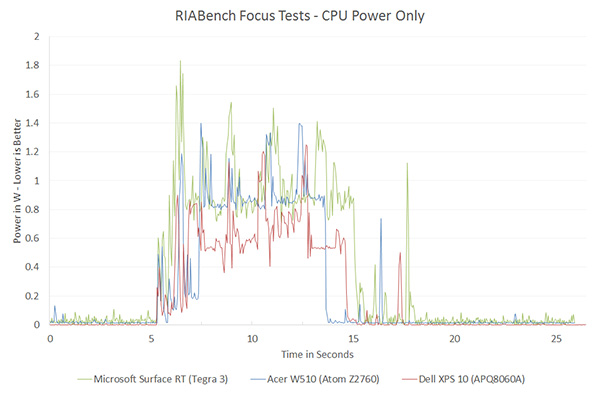
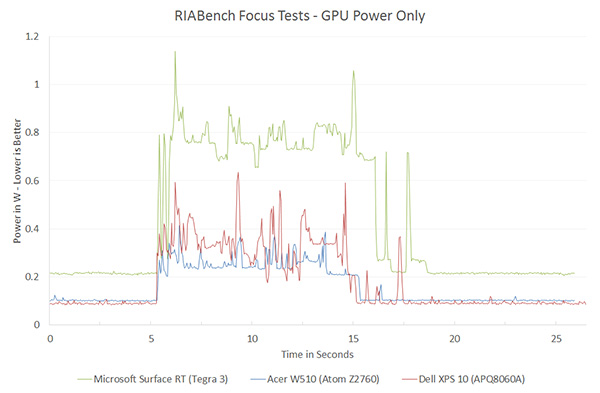








140 Comments
View All Comments
StrangerGuy - Sunday, March 24, 2013 - link
You really think having a slightly better chip would make Samsung risk everything to get locked into a chip with an ISA owned, designed and manufactured by one single sole supplier? And when that supplier in question historically has shown all sorts of monopolistic abuses?And when a quad A7 could already scroll desktop sites in Android capped at 60 fps additional performance provides very little real world advantage for most users. I'll even say most users would be annoyed by I/O bottlenecks like LTE speeds long before saying 2012+ class ARM CPUs are too slow.
duploxxx - Monday, January 7, 2013 - link
Now it is clear that when Intel provides that much material and resources that they know they are at least ok in the comapere against ARM on cpu and power... else they wouldn't make such a fuss...,but what about GPU? any decent benchmark or testing available on GPU performance.
I played in december with HP envy2 and after some questioning they installed a few light games which were "ok" but i wonder how well the gpu in the atom really is, power consumption looks ok, but i preffer a performing gpu @ a bit higher power then a none performing one.
memosk - Tuesday, January 8, 2013 - link
It looks like old problem with PowerPc v.s. PC .PowerPC have had a faster Risc procesor and PC have had slower x86 like procesor .
The end result was that clasical PC has won this Battle . Because of tradition and what is more important , you need knowledge about platform over users, producers, programers ...
And you should think about economical thinks like mortage and whole enviroment named as Logistik.
The same problem was Tesla vs. Edison. Tesla have had better ideas and Edison was Bussines-man. Who has won ? :)
memosk - Tuesday, January 8, 2013 - link
Nokia tryed seriosly sell windows 8 phones without SD cards And they said because of microsoft .How can you then compete again android with SD cards. But if you copy an Apple you think it has logic.
You need generaly: complete and logic and OWN and CONSISTENT and ORIGINAL strategy.
If you copy something it is dangerous that you strategy will be incostintent , leaky , "two way" , vague also with tragical errors like incompatibility or like legendary siemens phones: 1 crash per day . :D
apozean - Friday, January 11, 2013 - link
I studied the setup and it appears and Intel just wants to take on Nvidia's Tegra 3. Here are a couple of differences that I think are not highlighted appropriately:1. They used an Android tablet for Atom, Android tablet for Krait, but a Win RT (Surface) for Tegra 3. It must have been very difficult to fund a Google Nexus 7. Keeping the same OS across the devices would have controlled for a lot of other variables. Wouldn't it?
2. Tegra 3 is the only quad core chip among chips being compared. Atom and Krait are dual-core. If all four cores are running, wouldn't it make a different to the idle power?
3. Tegra 3 is built on 40nm and is one of the first A9 SoCs. In contrast, Atom is 32nm and Krait is 28nm.
How does Tegra 3 fits in this setup?
apozean - Friday, January 11, 2013 - link
Fixing typos..I studied the setup and it appears that Intel just wants to take on Nvidia's Tegra 3. Here are a couple of differences that I think are not highlighted appropriately:
1. They used an Android tablet for Atom, Android tablet for Krait, but a Win RT (Surface) for Tegra 3. It must have been very difficult to fund a Google Nexus 7. Keeping the same OS across the devices would have controlled for a lot of other system variables. Wouldn't it?
2. Tegra 3 is the only quad core chip among chips being compared. Atom and Krait are dual-core. If all four cores are running, wouldn't it make a difference to the idle power?
3. Tegra 3 is built on 40nm and is one of the first A9 SoCs. In contrast, Atom is 32nm and Krait is 28nm.
How does Tegra 3 fit in this setup?
some_guy - Wednesday, January 16, 2013 - link
I thinking this may be the beginning of Intel being commoditied and the end of the juicy margins for most of their sales.I was just reading an article about how hedge funds love Intel. I don't see it, but that doesn't mean that the hedge funds would make money. Perhaps they know the earning report that is coming out soon, maybe tomorrow, will be good. http://www.insidermonkey.com/blog/top-semiconducto...
some_guy - Wednesday, January 16, 2013 - link
I meant to say "but that doesn't mean that the hedge funds won't make money."raptorious - Wednesday, February 20, 2013 - link
but Anand has no clue what the rails might actually be powering. How do we know that the "GPU Rail" is in fact just powering the GPU and not the entire uncore of the SOC? This article is completely biased towards Intel and lacks true engineering rigor.EtTch - Tuesday, April 2, 2013 - link
My take in all of this is that ARM and x86 is in comparable at this point when it comes to comparing the different instruction set architectures due to different the lithography size and the new 3d transistors. When ARM based SOC has finally all the physical features of the x86 then it's only truly comparable. Right now x86 is most likely to have a lower power consumption than ARM based processors that has a higher lithographic size than itself. (I really don't know what it's called but I'll go out on a limb and call it lithography size even though I know that I am most likely wrong)